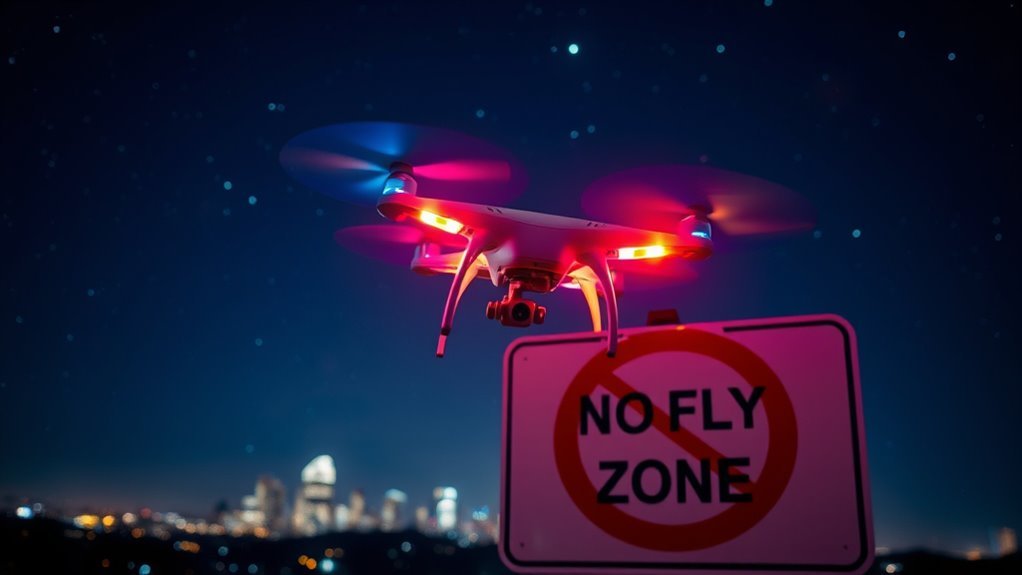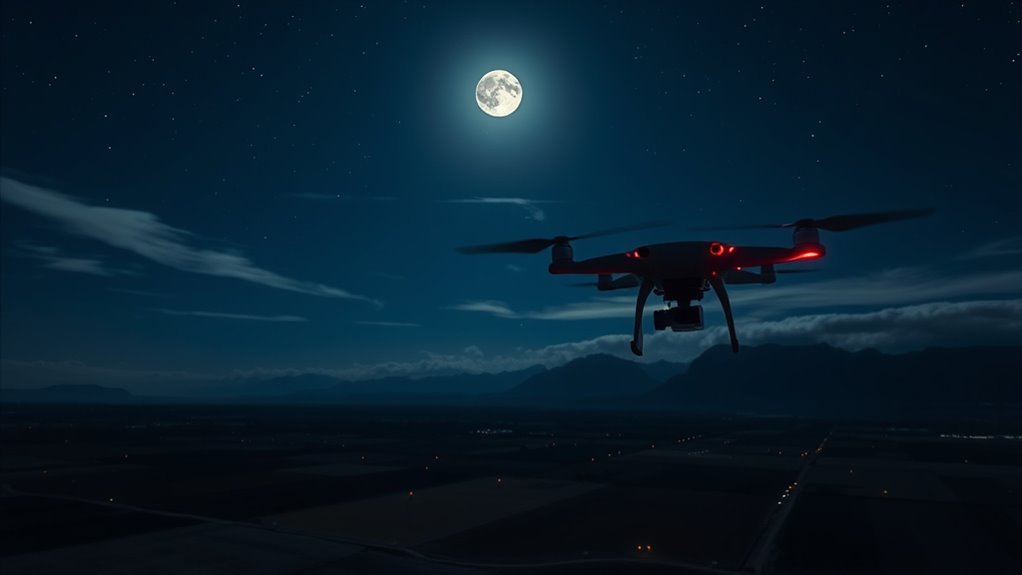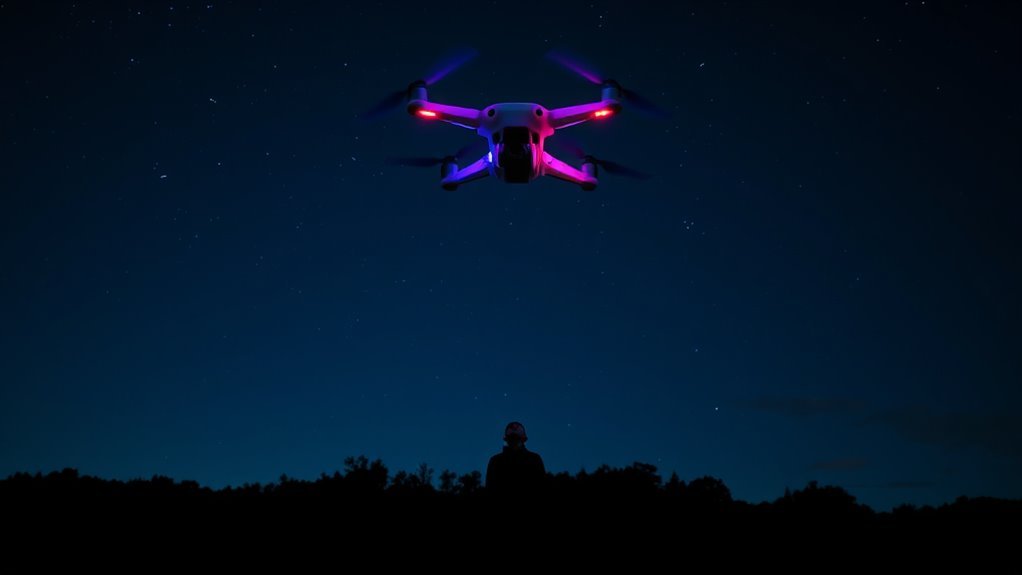To fly drones at night, you must comply with specific regulations, including obtaining a night flight certification and ensuring your drone has the required FAA-compliant lighting. This includes anti-collision lights and sufficient visibility for navigation. Local laws may impose additional restrictions, and thorough pre-flight planning is essential to assess risks like limited visibility and weather conditions. Knowing the full range of requirements and best practices is vital for safe operations; more details will follow.
Understanding the Legal Framework for Nighttime Drone Operations

When operating drones at night, it’s vital to understand the legal framework governing these activities, as regulations can vary considerably by jurisdiction. You’ll need to stay updated on regulatory changes, especially as nighttime technology evolves. Many areas require specific permits or certifications for night flights, and understanding these requirements is important to avoid penalties. Additionally, the Federal Aviation Administration (FAA) and local bodies frequently issue regulatory updates that impact how you can operate. Familiarizing yourself with these rules not only guarantees compliance but also enhances your freedom to fly responsibly. Always check for local laws, as they may impose additional restrictions that could affect your nighttime operations. Being informed empowers you to navigate this landscape effectively.
Required Lighting and Visibility Standards

When flying drones at night, you need to adhere to specific lighting equipment requirements to guarantee safety and compliance. Visibility distance regulations also play an important role in nighttime operations, as they dictate how far your drone can be seen. Additionally, obtaining the necessary night flight certifications is essential for legal operation in low-light conditions.
Lighting Equipment Requirements
Although flying drones at night offers unique opportunities, it also requires adherence to specific lighting equipment standards to confirm safety and compliance. To confirm proper drone illumination, your drone must be equipped with lighting that meets FAA light specifications. This typically includes a minimum of anti-collision lights that are visible from all directions. You should use white lights for forward illumination and red or green lights for orientation indicators. The intensity of these lights must be strong enough to be seen from a considerable distance, allowing you to maintain situational awareness. By adhering to these lighting requirements, you not only comply with regulations but also enhance your safety and that of others in the airspace.
Visibility Distance Regulations
Meeting the required lighting standards is only one aspect of ensuring safe nighttime drone operations; visibility distance regulations are equally important. You need to maintain a minimum visibility distance to enhance safety and avoid collisions. Generally, drones must be visible to the operator at all times, which often means using visibility technologies like navigation lights and strobe lights. These help other pilots, as well as ground personnel, detect your drone more easily. Furthermore, local regulations may require specific distances based on the environment, such as urban or rural settings. Ensuring compliance with these visibility standards not only aids in drone detection but also promotes responsible flying, allowing you greater freedom while operating your drone at night.
Night Flight Certifications
To operate a drone at night, you’ll need to obtain the appropriate night flight certifications that guarantee compliance with required lighting and visibility standards. These certifications confirm you’ve completed specific operator training focused on nighttime operations. You’ll need to equip your drone with anti-collision lights and other required lighting systems to enhance visibility. Regulations typically mandate a minimum visibility distance, assuring you can see and avoid obstacles effectively.
Moreover, understanding how to navigate in reduced light conditions is vital for safety and compliance. Familiarize yourself with the operational limits set forth by your local aviation authority, as they vary by jurisdiction. Meeting these standards not only empowers your nighttime operations but also promotes responsible drone use.
Certification and Registration Requirements

Since flying drones at night presents unique challenges and risks, it’s vital to understand the certification and registration requirements that govern these operations. First, you must guarantee your drone is properly registered with the FAA. This involves obtaining a unique identifier for your aircraft, which is essential for accountability. Additionally, you need to hold a valid pilot certification, specifically a Part 107 Remote Pilot Certificate, which guarantees you have the necessary knowledge of regulations and operational safety. Night operations require extra caution, and being certified demonstrates your competence in managing these risks. Ignoring these requirements could not only lead to penalties but also jeopardize your freedom to operate your drone effectively in the nighttime sky.
Pre-Flight Planning Considerations
Before you take to the skies at night, it’s essential to conduct thorough pre-flight planning to secure a safe and successful operation. Start with a pre-flight checklist that includes essential elements like battery levels, firmware updates, and GPS functionality. Next, perform a risk assessment to identify potential hazards specific to nighttime flying, such as limited visibility and unexpected obstacles.
Here’s a simple table to help you organize your planning:
| Checklist Item | Importance | Notes |
|---|---|---|
| Battery Check | Critical for flight duration | Validate full charge |
| Firmware Update | Necessary for performance | Check for latest version |
| GPS Functionality | Essential for navigation | Test signal strength |
| Obstacle Awareness | Safety priority | Plan flight path carefully |
Best Practices for Safe Nighttime Flying
While flying a drone at night can be exhilarating, adhering to best practices is essential for ensuring safety and compliance with regulations. First, equip your drone with proper lighting for visibility during nighttime navigation. Use bright, steady lights to help you maintain orientation and avoid obstacles. Before taking off, familiarize yourself with the area, as low-light conditions can obscure landmarks. Always keep your drone within visual line of sight to enhance flight safety. Utilizing a reliable GPS system can aid in navigation, but don’t solely depend on it. Additionally, understanding battery life differences is crucial, as colder temperatures can reduce flight time. In fact, advanced battery technology like that found in Draganfly Vital Intelligence can optimize power usage and enhance flight duration. Finally, stay updated on battery life, as colder temperatures can reduce flight time. By following these practices, you’ll enhance your nighttime flying experience while prioritizing safety and regulatory adherence.
Local Laws and Restrictions
Understanding local laws and restrictions is essential for anyone planning to fly a drone at night. Many areas impose specific local drone regulations that can vary greatly from state to state or even within municipalities. These regulations often include nighttime flight restrictions designed to enhance safety and minimize disturbances. Before you take to the skies, check your local government’s guidelines to guarantee compliance. Some regions may require you to obtain special permits or follow certain operational protocols, such as utilizing anti-collision lights. Ignoring these local laws can result in fines or restrictions that could limit your freedom to fly. Stay informed and navigate the legal landscape to enjoy a hassle-free nighttime flying experience.
Consequences of Non-Compliance With Regulations
If you fail to comply with night flying regulations for drones, you could face significant legal penalties, including fines or even criminal charges. Additionally, non-compliance poses safety risks not just to yourself, but also to others in the airspace and on the ground. Understanding these consequences is essential for responsible drone operation.
Legal Penalties
Failing to comply with regulations governing nighttime drone operations can lead to significant legal penalties. Violations may result in hefty fines, which can vary depending on the severity of the infraction and the jurisdiction. In some cases, you might even face criminal charges, leading to potential imprisonment. Legal consequences also extend to the loss of your drone license or registration, severely limiting your operational freedom. Enforcement measures are actively pursued by aviation authorities, who monitor compliance through various methods, including surveillance and public reports. Understand that ignorance of the law isn’t a defense; staying informed about regulations is vital. By adhering to the rules, you not only protect your rights but also contribute to the responsible use of airspace.
Safety Risks
Non-compliance with nighttime drone regulations poses significant safety risks that can endanger both the operator and the public. Without adequate night vision technology and proper risk assessment, you could lose control of your drone, leading to accidents or collisions. Below is a summary of potential safety risks:
| Risk Factor | Consequence | Mitigation Strategy |
|---|---|---|
| Lack of Night Vision | Increased collision risk | Use drones with night vision |
| Poor Visibility | Difficulty in navigation | Follow lighting regulations |
| Inadequate Training | Operator error | Complete training programs |
| Weather Conditions | Reduced control | Monitor weather reports |
| Ignoring Regulations | Legal penalties, accidents | Stay informed on laws |
Understanding these risks helps you operate your drone safely and responsibly at night.
Frequently Asked Questions
Can I Fly a Drone at Night Without a Special Permit?
You can’t fly a drone at night without a special permit. Guaranteeing drone safety and maintaining night visibility are essential. Always check local regulations before flying to avoid potential legal issues and secure safe operations.
What Are the Penalties for Flying a Drone Illegally at Night?
If you fly a drone illegally at night, penalties overview may include fines, suspension of your license, or even criminal charges. Such drone violations can greatly restrict your freedom to operate in the future.
Are There Specific Drones Prohibited From Nighttime Use?
Did you know that over 20% of drone accidents occur at night? Certain drone types may face nighttime restrictions based on their specifications, ensuring safety and compliance. Always check regulations before flying to avoid penalties.
How Do Weather Conditions Affect Night Flying Regulations?
Weather conditions markedly impact night visibility, affecting your drone’s operational limits. Low visibility due to fog, rain, or snow may restrict flying and require you to assess safety and compliance before operating your drone at night.
Can I Use Night Vision Technology for Nighttime Drone Flights?
Imagine soaring through a moonlit sky; you can indeed use night vision or thermal imaging technology for nighttime drone flights. Just guarantee you’re compliant with regulations to maintain safety and avoid unwanted trouble.

